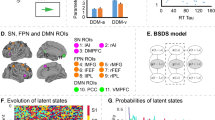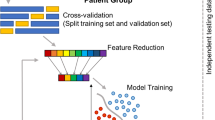Abstract
Although attention plays a ubiquitous role in perception and cognition, researchers lack a simple way to measure a person's overall attentional abilities. Because behavioral measures are diverse and difficult to standardize, we pursued a neuromarker of an important aspect of attention, sustained attention, using functional magnetic resonance imaging. To this end, we identified functional brain networks whose strength during a sustained attention task predicted individual differences in performance. Models based on these networks generalized to previously unseen individuals, even predicting performance from resting-state connectivity alone. Furthermore, these same models predicted a clinical measure of attention—symptoms of attention deficit hyperactivity disorder—from resting-state connectivity in an independent sample of children and adolescents. These results demonstrate that whole-brain functional network strength provides a broadly applicable neuromarker of sustained attention.
This is a preview of subscription content, access via your institution
Access options
Subscribe to this journal
Receive 12 print issues and online access
$209.00 per year
only $17.42 per issue
Buy this article
- Purchase on Springer Link
- Instant access to full article PDF
Prices may be subject to local taxes which are calculated during checkout




Similar content being viewed by others
References
Cattell, R.B. Intelligence: Its Structure, Growth and Action (Elsevier, 1987).
Jaeggi, S.M., Buschkuehl, M., Jonides, J. & Perrig, W.J. Improving fluid intelligence with training on working memory. Proc. Natl. Acad. Sci. USA 105, 6829–6833 (2008).
Unsworth, N., Fukuda, K., Awh, E. & Vogel, E.K. Working memory and fluid intelligence: capacity, attention control, and secondary memory retrieval. Cognit. Psychol. 71, 1–26 (2014).
Kyllonen, P.C. & Christal, R.E. Reasoning ability is (little more than) working-memory capacity?!. Intelligence 14, 389–433 (1990).
Engle, R.W., Kane, M.J. & Tuholski, S.W. in Models of Working Memory: Mechanisms of Active Maintenance and Executive Control (eds. Miyake, A. & Shah, P.) 102–134 (1999).
Luck, S.J. & Vogel, E.K. Visual working memory capacity: from psychophysics and neurobiology to individual differences. Trends Cogn. Sci. 17, 391–400 (2013).
Chun, M.M., Golomb, J.D. & Turk-Browne, N.B. A taxonomy of external and internal attention. Annu. Rev. Psychol. 62, 73–101 (2011).
Rosenberg, M.D., Finn, E.S., Todd Constable, R. & Chun, M.M. Predicting moment-to-moment attentional state. Neuroimage 114, 249–256 (2015).
Warm, J.S., Parasuraman, R. & Matthews, G. Vigilance requires hard mental work and is stressful. Hum. Factors 50, 433–441 (2008).
Desimone, R. & Duncan, J. Neural mechanisms of selective visual attention. Annu. Rev. Neurosci. 18, 193–222 (1995).
Kastner, S. & Ungerleider, L.G. The neural basis of biased competition in human visual cortex. Neuropsychologia 39, 1263–1276 (2001).
Corbetta, M. & Shulman, G.L. Control of goal-directed and stimulus-driven attention in the brain. Nat. Rev. Neurosci. 3, 201–215 (2002).
Posner, M.I. & Rothbart, M.K. Research on attention networks as a model for the integration of psychological science. Annu. Rev. Psychol. 58, 1–23 (2007).
deBettencourt, M.T., Cohen, J.D., Lee, R.F., Norman, K.A. & Turk-Browne, N.B. Closed-loop training of attention with real-time brain imaging. Nat. Neurosci. 18, 470–475 (2015).
Rosvold, H.E., Mirsky, A.F., Sarason, I., Bransome, E.D. & Beck, L.H. A continuous performance test of brain damage. J. Consult. Psychol. 20, 343–350 (1956).
Riccio, C., Reynolds, C. & Lowe, P. Clinical applications of continuous performance tests: measuring attention and impulsive responding in children and adults. Arch. Clin. Neuropsychol. 20, 559–560 (2001).
Esterman, M., Noonan, S.K., Rosenberg, M. & Degutis, J. In the zone or zoning out? Tracking behavioral and neural fluctuations during sustained attention. Cereb. Cortex 23, 2712–2723 (2013).
Rosenberg, M., Noonan, S., DeGutis, J. & Esterman, M. Sustaining visual attention in the face of distraction: a novel gradual-onset continuous performance task. Atten. Percept. Psychophys. 75, 426–439 (2013).
Fortenbaugh, F.C. et al. Sustained attention across the life span in a sample of 10,000 dissociating ability and strategy. Psychol. Sci. 26, 1497–1510 (2015).
Barkley, R.A. Behavioral inhibition, sustained attention, and executive functions: constructing a unifying theory of ADHD. Psychol. Bull. 121, 65–94 (1997).
Shen, X., Papademetris, X. & Constable, R.T. Graph-theory based parcellation of functional subunits in the brain from resting-state fMRI data. Neuroimage 50, 1027–1035 (2010).
Shen, X., Tokoglu, F., Papademetris, X. & Constable, R.T. Groupwise whole-brain parcellation from resting-state fMRI data for network node identification. Neuroimage 82, 403–415 (2013).
Rubinov, M. & Sporns, O. Complex network measures of brain connectivity: Uses and interpretations. Neuroimage 52, 1059–1069 (2010).
Steiger, J.H. Tests for comparing elements of a correlation matrix. Psychol. Bull. 87, 245–251 (1980).
The ADHD-200 Consortium. The ADHD-200 Consortium: a model to advance the translational potential of neuroimaging in clinical neuroscience. Front. Syst. Neurosci. 6, 62 (2012).
DuPaul, G.J., Power, T.J., Anastopoulos, A.D. & Reid, R. ADHD Rating Scale-IV: Checklists, Norms, and Clinical Interpretation (Guilford Press, New York, 1998).
Li, D., Jin, Y., Vandenberg, S.G., Zhu, Y.M. & Tang, C.H. Report on Shanghai norms for the Chinese translation of the Wechsler Intelligence Scale for Children-Revised. Psychol. Rep. 67, 531–541 (1990).
Finn, E.S. et al. Functional connectome fingerprinting: identifying individuals using patterns of brain connectivity. Nat. Neurosci. 18, 1664–1671 (2015).
Stoodley, C.J. The cerebellum and cognition: evidence from functional imaging studies. Cerebellum 11, 352–365 (2012).
Buckner, R.L. The cerebellum and cognitive function: 25 years of insight from anatomy and neuroimaging. Neuron 80, 807–815 (2013).
Castellanos, F.X. & Proal, E. Large-scale brain systems in ADHD: beyond the prefrontal-striatal model. Trends Cogn. Sci. 16, 17–26 (2012).
Krain, A.L. & Castellanos, F.X. Brain development and ADHD. Clin. Psychol. Rev. 26, 433–444 (2006).
Huang, L., Mo, L. & Li, Y. Measuring the interrelations among multiple paradigms of visual attention: an individual differences approach. J. Exp. Psychol. Hum. Percept. Perform. 38, 414–428 (2012).
Baldassarre, A. et al. From the cover: individual variability in functional connectivity predicts performance of a perceptual task. Proc. Natl. Acad. Sci. USA 109, 3516–3521 (2012).
Smith, S.M. et al. Functional connectomics from resting-state fMRI. Trends Cogn. Sci. 17, 666–682 (2013).
Gabrieli, J.D.E., Ghosh, S.S. & Whitfield-Gabrieli, S. Prediction as a humanitarian and pragmatic contribution from human cognitive neuroscience. Neuron 85, 11–26 (2015).
Whelan, R. et al. Neuropsychosocial profiles of current and future adolescent alcohol misusers. Nature 512, 185–189 (2014).
Rosenberg, M.D., Finn, E.S., Constable, R.T. & Chun, M.M. Predicting moment-to-moment attentional state. Neuroimage 114, 249–256 (2015).
Langner, R. & Eickhoff, S.B. Sustaining attention to simple tasks: a meta-analytic review of the neural mechanisms of vigilant attention. Psychol. Bull. 139, 870–900 (2013).
Turk-Browne, N.B. Functional interactions as big data in the human brain. Science 342, 580–584 (2013).
Cao, Q. et al. Abnormal neural activity in children with attention deficit hyperactivity disorder: a resting-state functional magnetic resonance imaging study. Neuroreport 17, 1033–1036 (2006).
Tian, L. et al. Altered resting-state functional connectivity patterns of anterior cingulate cortex in adolescents with attention deficit hyperactivity disorder. Neurosci. Lett. 400, 39–43 (2006).
Uddin, L.Q. et al. Network homogeneity reveals decreased integrity of default-mode network in ADHD. J. Neurosci. Methods 169, 249–254 (2008).
Wang, L. et al. Altered small-world brain functional networks in children with attention-deficit/hyperactivity disorder. Hum. Brain Mapp. 30, 638–649 (2009).
Fair, D.A. et al. Atypical default network connectivity in youth with attention-deficit/hyperactivity disorder. Biol. Psychiatry 68, 1084–1091 (2010).
Qiu, M.G. et al. Changes of brain structure and function in ADHD children. Brain Topogr. 24, 243–252 (2011).
Tomasi, D. & Volkow, N.D. Abnormal functional connectivity in children with attention-deficit/hyperactivity disorder. Biol. Psychiatry 71, 443–450 (2012).
Cocchi, L. et al. Altered functional brain connectivity in a non-clinical sample of young adults with attention-deficit/hyperactivity disorder. J. Neurosci. 32, 17753–17761 (2012).
Joshi, A. et al. Unified framework for development, deployment and robust testing of neuroimaging algorithms. Neuroinformatics 9, 69–84 (2011).
Kaufman, J. et al. Schedule for Affective Disorders and Schizophrenia for School-Age Children-Present and Lifetime Version (K-SADS-PL): initial reliability and validity data. J. Am. Acad. Child Adolesc. Psychiatry 36, 980–988 (1997).
Friedman, L. & Glover, G.H. The FBIRN Consortium Reducing interscanner variability of activation in a multicenter fMRI study: controlling for signal-to-fluctuation-noise-ratio (SFNR) differences. Neuroimage 33, 471–481 (2006).
Scheinost, D., Papademetris, X. & Constable, R.T. The impact of image smoothness on intrinsic functional connectivity and head motion confounds. Neuroimage 95, 13–21 (2014).
Acknowledgements
M.D.R. and E.S.F. are supported by US National Science Foundation Graduate Research Fellowships. This work was also supported by US National Institutes of Health EB009666 to R.T.C. and T32 DA022975 to D.S. Data were provided by the ADHD-200 Consortium25, coordinated by M.P. Milham. Data collection at Peking University was supported by the following funding sources: The Commonwealth Sciences Foundation, Ministry of Health, China (200802073); The National Foundation, Ministry of Science and Technology, China (2007BAI17B03); The National Natural Sciences Foundation, China (30970802); The Funds for International Cooperation of the National Natural Science Foundation of China (81020108022); The National Natural Science Foundation of China (8100059); and the Open Research Fund of the State Key Laboratory of Cognitive Neuroscience and Learning.
Author information
Authors and Affiliations
Contributions
M.D.R., M.M.C., E.S.F. and R.T.C. conceived of and designed the study. E.S.F. developed the prediction methodology. M.D.R., E.S.F., X.S. and D.S. wrote the code. M.D.R. collected and preprocessed the gradCPT data. DS preprocessed the ADHD-200 data. M.D.R. ran the models and analyzed the output data with support and contributions from E.S.F. X.P., X.S. and D.S. contributed previously unpublished tools, including the specific functional brain parcellation used here and visualization software. M.D.R. wrote the paper with contributions from E.S.F. and M.M.C. All other authors commented on the paper.
Corresponding author
Ethics declarations
Competing interests
The authors declare no competing financial interests.
Integrated supplementary information
Supplementary Figure 1 The 236-region functional parcellation used to define network nodes in the ADHD-200 dataset.
Colored nodes were included in the atlas, whereas regions in faint gray were not. These regions, located mainly in the inferior portions of the cerebellum, brainstem, temporal poles and orbital frontal cortex, were excluded because some scans in the ADHD-200 dataset did not include full cortex and cerebellum coverage.
Supplementary Figure 2 Spearman’s (rank) correlations between predicted and observed d' values.
Models were trained on task data from n – 1 gradCPT subjects and tested on data from the left-out individual. Spearman’s correlation, rather than robust regression, was used at the edge selection step.
Supplementary information
Supplementary Text and Figures
Supplementary Figures 1 and 2 and Supplementary Tables 1–3 (PDF 502 kb)
Rights and permissions
About this article
Cite this article
Rosenberg, M., Finn, E., Scheinost, D. et al. A neuromarker of sustained attention from whole-brain functional connectivity. Nat Neurosci 19, 165–171 (2016). https://doi.org/10.1038/nn.4179
Received:
Accepted:
Published:
Issue Date:
DOI: https://doi.org/10.1038/nn.4179



